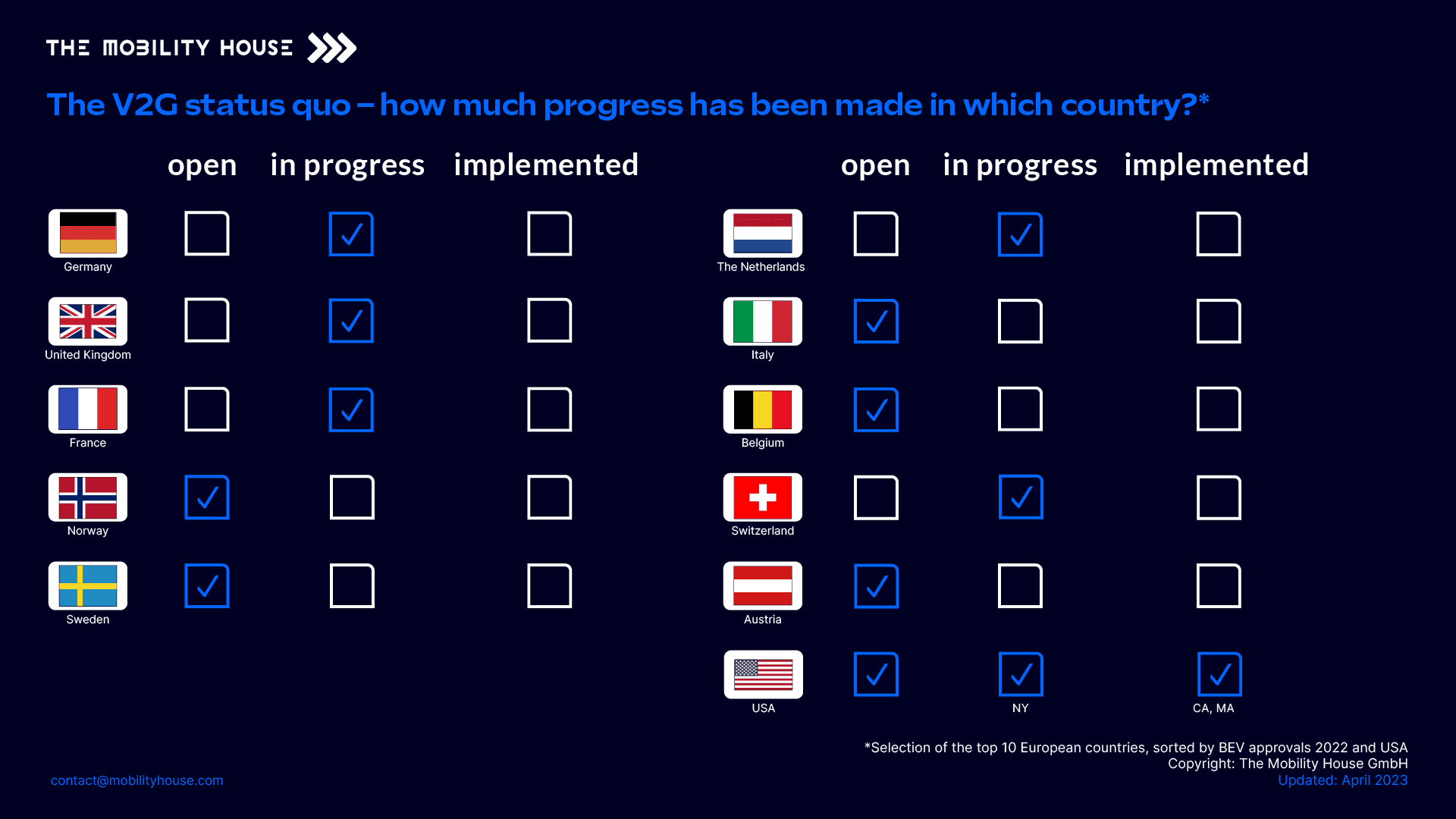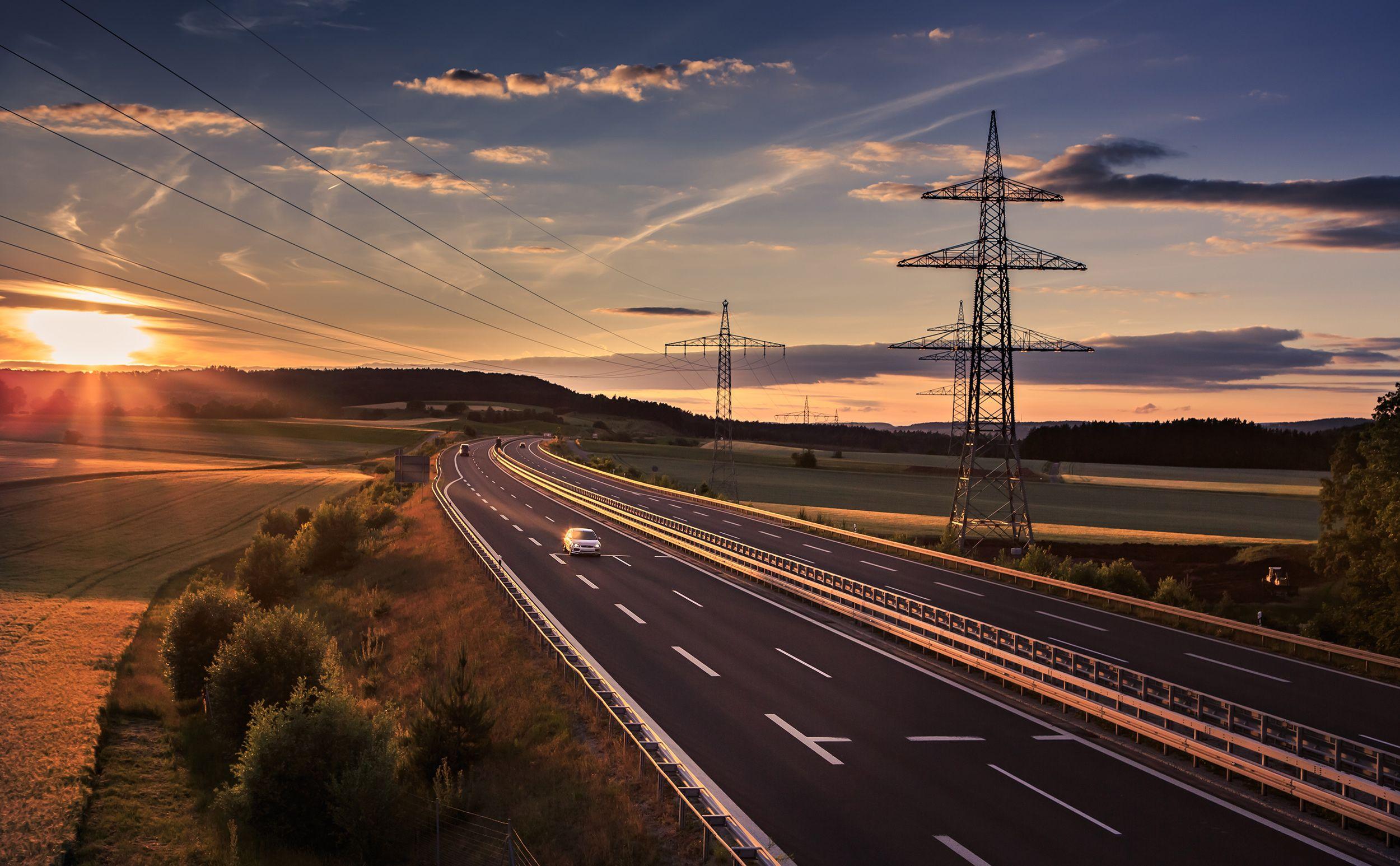Vehicle-to-Grid in Germany
Things are progressing in Germany. The 2021 coalition agreement entitled “Dare to make more progress” even stated “We will enable bidirectional charging …” . In the Charging Infrastructure Master Plan II, which was published recently in October 2022, the German Federal Government has set Q2 of 2023 as a new target. Measure 47 states: “ The flexibilities of electric vehicles and the associated energy-economy opportunities can and should be harnessed for the electricity system – especially in the form of bidirectional charging” .
The essential legal adjustments are:
- Stopping double loading of electricity that is temporarily stored in mobile vehicle batteries in line with stationary storage. This can be implemented by defining mobile energy storage in a standardized manner.
- Ensuring practical measurement and control specifications . Establishing cost- and process-efficient collection and distinction of bidirectional charging electricity (e.g. less expensive smart meter gateway (SMGW), in-vehicle metering, etc.).
- Enabling market-based procurement of flexibility for the power grid and marketing on the electricity market. Establishing variable energy and network tariffs. Market-based grid tariff mechanisms must be used to ensure that only necessary grid expansion takes place and that the grid is relieved as opposed to strained by energy market optimization.
- Ensuring standardized mains connection conditions for the charging infrastructure, not to mention defining terms (e.g. an “end consumer”) in a standardized manner across all relevant laws (the German Energy Industry Act, the German Renewable Energy Sources Act, the German Act on Combined Heat and Power Generation, etc.).
All the legal requirements to enable bidirectional charging have already been drawn up to the letter since April 2022 as part of the accompanying research for the German Federal Ministry for Economic Affairs and Climate Action. Additionally, the necessary regulatory adjustments for V2G are labelled “no-regret” measures in the RED II amendment bidirectional charging is also already provided for in the Alternative Fuels Infrastructure and Repealing Directive (AFIR).
The implementation of V2G by country

Vehicle-to-Grid in the Netherlands
With around 90,000 charging points, The Netherlands has become Europe’s electromobility mecca. In Arnhem and Utrecht in particular, several projects aiming to examine bidirectional charging are already ongoing. Among other things, Hyundai is launching a V2G trial in Utrecht with the Ioniq 5. Since 2019, a project has been underway at Amsterdam’s Johan Cruijff ArenA (JCA) – with the collaboration of The Mobility House – to connect a bidirectional vehicle to the existing 3 MW battery storage, consisting of 148 Nissan Leaf batteries, and the 1 MW photovoltaic installation on the arena’s roof using innovative charging and energy management. The Mobility House’s smart software control system enables stadium visitors’ electric cars – with the owner’s consent – to not only draw electricity from the charging station, but also to deliver it back to the stadium in an intelligently controlled manner while their vehicle is parked on the premises.
Vehicle-to-Grid in the United Kingdom
Of all the countries mentioned, the UK is the furthest along in regulatory terms and is consistently pushing ahead with bidirectional charging. The Department for Business, Energy & Industrial Strategy is setting the framework for V2G under the heading “Delivering a smart and secure electricity system”. Words have already been translated into action on the island nation. The department is funding 20 V2G projects to the tune of GBP 30 million, and so around 600 cars are involved in the field trial. The results are currently being evaluated, and the regulatory adjustments are being prepared by the Office of Gas and Electricity Markets (OFGEM).
Vehicle-to-Grid in Japan
The topic of V2G was born in the Land of the Rising Sun. Following on from the reactor disaster at Fukushima nuclear power plant in 2011, bidirectionality was added to CHAdeMO, the Japanese charging standard. The aim of this endeavor was to use all electric cars as a backup power supply in case of an emergency. There are no plans at present for further integration into the energy market.
Vehicle-to-Grid in the USA
In the USA, Vehicle-to-Grid is making progress. Cars like the Ford F150 Lightning are harbingers of the fact that a smart power grid will be and must be set up in the large country on the other side of the Atlantic as well. The U.S. Department of Energy has signed a memorandum of understanding with several key companies to implement Vehicle-to-Everything, which states: “ With their immense potential for increasing the country’s energy security, economic vitality, and quality of life, [bidirectional] plug-in electric vehicles (PEVs) … will play a key role in the country’s transportation future. ” Another maxim explicitly mentioned in this agreement is customer or user friendliness. This is necessary to make V2X – and thus V2G – suitable for large-scale use in the USA.
Interestingly, the U.S. Department of Defense launched a V2G field trial with electric sedans in Southern California back in 2013. Nowadays, electric school buses are playing the primary role in V2G projects. The conditions of the yellow-orange passenger vehicles are ideal for bidirectional charging. An average bus has a battery capacity of 220 kWh and is operational for about six hours a day, 200 days a year. The rest of the time, the powerful batteries are available to stabilize the power grid with their energy. In Beverly, Massachusetts, these school buses fed a total of 3 MWh of electricity back into the grid over around 50 hours in 2021. That’s enough to power 100 single-family homes for a day.
In Southern California’s Cajon Valley near San Diego, a similar project launched in the summer of 2022, integrating electric school buses into a power grid as V2G elements during the 2022/23 school year. The vehicles are equipped with the appropriate telematics to enable analysis of the batteries and charging behavior. Utility company San Diego Gas and Electric (SDG&E) – the lead energy operator – expects V2G participants to receive USD 2 per kWh.
The Mobility House and New York City School Bus Umbrella Services (NYCSBUS) are also testing V2G in a project in New York City . Basically, both partners are concerned with adapting the charging processes of purely electric school buses to the circulations as well as the electricity prices to keep the charging costs as low as possible. It is also important to avoid or keep as low as possible the investment costs of a grid connection expansion.
